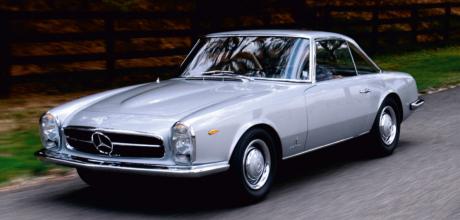1964 Mercedes-Benz 230SL Coupe Pininfarina W113
Pininfarina hoped to win Mercedes-Benz’s favour by presenting this alternative to one of their most-loved designs. By international correspondent Richard Truesdell.
Pagoda W113 Mercedes 230 SL Pininfarina
ALTERNATIVE PERFECTION
World-class cars: Mercedes-Benz Pininfarina 230 SL coupe
Imagine it’s October 1964 and you’re an automotive journalist covering that year’s Paris Auto Show (Mondial de l’Automobile). As you approach the Pininfarina booth you come across a car that looks a bit like the Mercedes-Benz 230SL W113 introduced the previous year at the Geneva Auto Show, a car then arriving at Mercedes-Benz dealerships around the world.
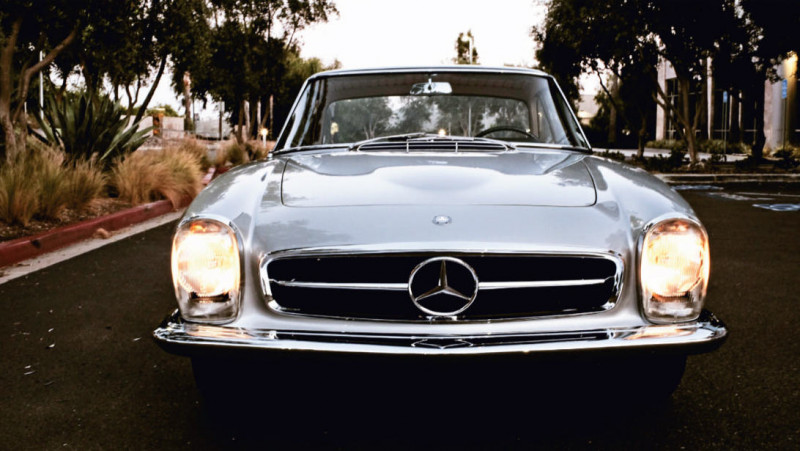
But looking closely, its styling and proportions seem to be a bit different. And it has a fixed roof, unlike the Pagoda-style greenhouse of the removable hardtop seen on the production 230SL. While today the styling of the W113 — produced under the supervision of head of styling Friedrich Geiger by lead designers Paul Bracq and Bela Barenyi — is considered a mid-century modern masterpiece, it was not universally praised at the time. Some critics particularly took against the concave design of its removable roof, which gave the car its Pagoda nickname.
“While today the styling of the W113 is considered a mid-century modern masterpiece, it was not universally praised at the time”
After the 230 SL roadster’s introduction, Pininfarina approached Mercedes-Benz to produce a fixed-roof version of the car. At Pininfarina, the job was handed to a recently arrived American designer, Tom Tjaarda, who had come over from Ghia. He was just 29 years old at the time. The young Tjaarda, who by that time had already left his styling imprint on the Pininfarina-credited Ferrari 330 GT 2+2 Series 1, took the already elegant Geiger/Bracq/Barenyi design, and with subtle changes — such as the cant of the front grille, flattening the side profile, and reshaping the contours of the deck lid — transformed the styling under the fixed roof. While still an SL-based design, with its thin A- and C-pillars, the car took on a unique appearance.

PRODUCTION FOCUS
Tjaarda left the interior mostly intact, which would make it easier for production, the exceptions being the seat frames, which received Ferrariesque seat cushions and new seat covers. The door panels were rearranged a bit with the subtraction of the armrests and the raking of the door grips. The headlining was tuck-and-roll with non-perforated material. The area behind the seats was restyled with a package tray but these minimal tweaks meant the interior was production-ready.
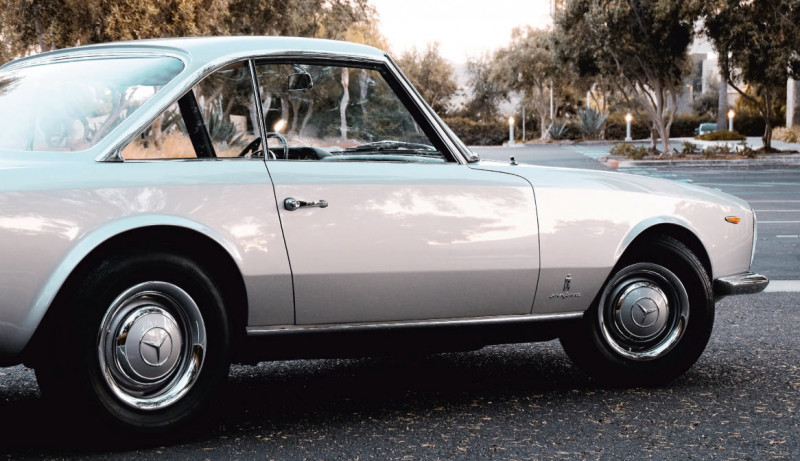
The lovely coupe, which some automotive styling critics felt looked as much like a Ferrari as a Mercedes, was one of the stars of that year’s Paris Auto Show. Unfortunately, that might not have been seen as an advantage as it did not elicit enough interest from Mercedes-Benz management for potential series production. Then as now, Mercedes-Benz rarely went outside of its in-house studios for projects with series production in mind. However, unlike many orphaned auto show concept cars that are ultimately destroyed, this car escaped the crusher and was sold to German press magnate Axel Springer.
Over the years, the car passed through a series of owners, one of whom was Springer’s former wife, Helga Ludeweg, and ultimately ended up in the United States. Various owners changed both the exterior and interior colours before the car was acquired by Weston Hook in 1997. Under more than two decades of the Hook family’s stewardship, the car was returned as close to its Paris Auto Show configuration as possible by Hjeltness Restoration, based in Escondido, California.
There the father-and-son team of Jerry and Eric Hjeltness restored the car in 1997 in less than 12 weeks, making it just in time for its first Pebble Beach appearance that year. Hjeltness Restoration was established in 1983 and has garnered a reputation as one of the world’s leading 300 SL restoration specialists. Eric noted that over the past 38 years, more than 50 300 SL Gullwings and roadsters have rolled through their shop, many receiving bumper-to-bumper restorations. Jerry, a machinist by training, always seemed to be working on a 300 SL while Eric was growing up, making the move to their own restoration shop a logical extension of Jerry’s expertise. In its first Pebble Beach appearance in 1997, when the car was 33 years old, it was a class winner.
“We found filler in many places. Don’t forget Michelangelo was a sculptor, also Italian, right? Pininfarina used filler, I am sure”
BACK TO ORIGINAL
Over the years the car, known as the Pininfarina coupe, had a succession of owners, mostly in America. During the 1990s the car was painted black with modern Mercedes-Benz cast-aluminum wheels. It was subsequently painted red by its next owner, and the interior was refinished with tan leather trim.
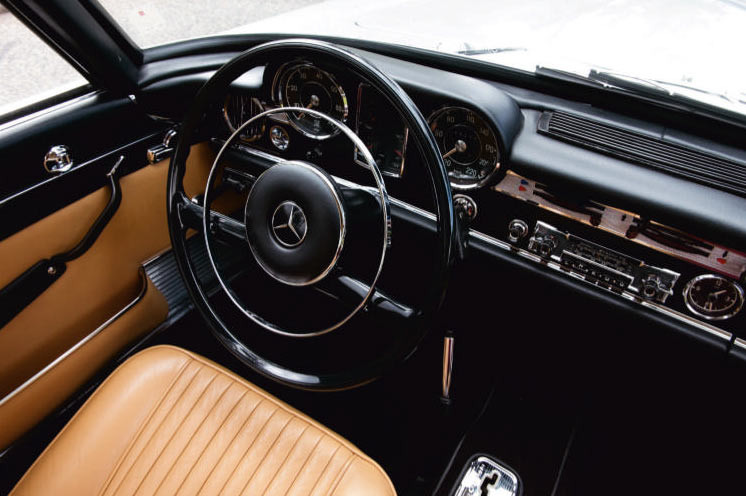
Then in the mid-1990s, the car caught the attention of Weston Hook, a noted American collector. In the years before buying it in 1997, Weston talked with Jerry at Hjeltness Restoration several times about acquiring the car for his collection. Jerry had said to Weston, “In red, it doesn’t do anything for me.” A few weeks later Weston called again, telling Jerry he’d bought the car and that it had already been accepted for Pebble Beach that year (12 weeks away), as there was a Tom Tjaarda Class, and could Jerry polish it and get it ready for this high-profile classic event? The red paint job was in need of serious attention. Jerry thought the rare, one-off Pininfarina coupe was, charitably, in less than concours condition.
When the car arrived at Hjeltness Restoration, Jerry gave Weston an honest appraisal of the situation. “We could try to polish this out, but the paint was bubbling,” he said. “The underside is painted black, and if the judges lean down and look at the underside they will laugh.”
Initially, Weston wanted the car repainted red, but after locating photos of it as exhibited in Paris in 1964, in silver, Hook decided to return it to its original 1964 show car configuration. And Jerry thought the car’s lines worked exceptionally well in silver. So with Pebble Beach closing in, all other work at Hjeltness Restoration halted as the crew concentrated on the Pininfarina coupe. Jerry’s son Eric, who works side-by-side with his father, recalls that the car was completed in less than 12 weeks.
Eric explained that the car was not taken back to the original sheet metal, but was sanded down to almost that point. In the course of preparing the car, Eric discovered that when it first came to Pininfarina from the factory, it was finished in white. “There were several levels of paint — white, silver, black, and red — where we prepped the car,” he says. “We also found filler in many places. Don’t forget Michelangelo was a sculptor, also Italian, right?
Pininfarina used filler, I am sure.” Eric also observed that when the car was exhibited in Paris in 1964, it had side marker lights from a Ferrari from that period. “The holes were filled, but it was easy to see the original locations when the body was ‘taken down’ for its new silver paint.”
GLASS DISASTER
One of the first things Jerry noticed was that the car had a Plexiglas windshield that had been installed before Weston purchased the car. “The restorer at the time, who painted the car red, apparently had broken the windshield during the restoration,” Jerry speculated.

He had a unique solution to the windshield problem. At the time Chrysler had an advanced design center in nearby Carlsbad, and Jerry had a friend there. “I had him come over and we pulled a plaster of Paris mold off of the existing Plexiglas windshield. Then I had a shop in Long Beach make a glass windshield.”
Thankfully, the interior was mostly correct but the aluminum kick panels, with their fine etchings, were in less than perfect shape. To recreate the kick panels Jerry, with his toolmaker expertise, made a tool to duplicate the originals.
When looking at the 1964 Paris photos, Weston noted a unique license plate frame and insisted Jerry duplicate it, even though it was missing from the car. At the time (1997) Jerry told Weston there wasn’t enough time, but as the restoration had gone without major complications, he attempted to replicate the frame, using the 1964 pictures Weston had. With these pictures, Jerry was able to get very accurate measurements.
One particular memory from the car’s 1997 Pebble Beach appearance is worth explaining, especially within the context of this updated version of the story. Jerry recalls, “Someone with a German accent walked up to it and said, ‘Here’s the car. We thought it was lost.” The German had apparently worked for Axel Springer. A week after Pebble Beach, he made contact with Hjeltness Restoration and arranged to have the car photographed at a nearby equestrian center in Rancho Santa Fe, California, and it subsequently appeared in 1998 in Auto Bild magazine in Germany.
In the time since its 1997 appearance at Pebble Beach, the car has been displayed at many events and is notable showings in the post-Weston Hook era was its appearance at Villa D’Este in May 2014, where it was displayed in the Prototype Car Design class. Tom Tjaarda appeared with the car along with the members of the Hook Family, including Weston’s wife Elona and their son Russell.

It remains an enduring legacy to the preservation efforts of Weston Hook, who sadly died 14 years ago, leaving Elona and Russell as its custodians. Here’s what Russell had to say when asked about this honour:
“While it is certainly an honour to own a piece of automotive history in the Pininfarina 230 SL, my mom and I know that this honour comes with much responsibility. My mother Elona and I look at the 230 SL and remember my dad fondly. I recall the first time I understood my dad’s love of line and need for speed.
HOOK HISTORY
“It was a typical hot and humid summer day in Hawaii. My dad piled my mom and the rest of us kids in a 1956 Corvette convertible for a drive. As we drove away, the neighborhood dog ran behind, then alongside, and finally jumped up and into the Corvette, and off we went. I heard my dad’s laughter and sheer joy of life as he drove around that day. We both miss him. His joy in discovering the longlost Pininfarina 230 SL, the frantic but loving restoration in time for the 1997 Pebble Beach Concours, the renewal of old friendships, and the new friendships that the 230 SL has brought into our lives. We are the richer for owning it.” The Pininfarina coupe is one of the cornerstones of a sizable collection of cars and stands at an intersection of the history of Mercedes-Benz, Pininfarina, and a young American designer, Tom Tjaarda, who over the course of his career would leave his mark on more than 80 additional concept and production vehicles. The car made a return appearance on the Pebble Beach fairway in 2005 celebrating Pininfarina’s 75th anniversary. It made its third appearance this year (2021).
The red paint was bubbling. After locating photos of it as exhibited in Paris in 1964 in silver, Hook decided to restore it to its 1964 show car configuration
Tjaarda recalls
The following interview was compiled from a series of email exchanges with Tom Tjaarda in 2014. He passed away in Italy in 2017 at the age of 82.
The son of John Tjaarda, responsible for the design of the aerodynamic 1936 Lincoln Zephyr, Tom had worked for Ghia before moving to Pininfarina in 1962, where his first project was a coupe version of the rear-engined Chevrolet Corvair. Then he went on to the design for the 1963 Ferrari 330 GT 2+2 Series 1, before moving to the 230 SL assignment.
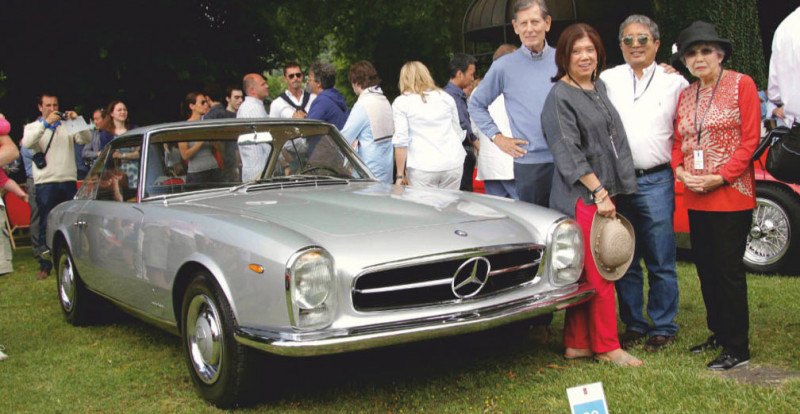
This was pretty heady stuff for a designer who wasn’t yet 30 years old in 1964. Tjaarda would put his signature on more than 80 concept and production designs over his long career, the two best-known production designs from this era being the 1965 Fiat 124 Spider while at Pininfarina, and the 1970 DeTomaso Pantera after moving back to Ghia.
Looking back more than 50 years, here’s what Tjaarda remembers about the development of the fixed-roof version of the 230 SL: “I cannot recall the exact date of the Mercedes project, but I think it would be some time in late 1963. I remember that it was going to be an attempt by Pininfarina to work together on an important project with Mercedes- Benz. The scope was to design a special version of the 230 SL in such a way that it could be put into production at the Pininfarina factory. For that reason, there were many carry-over components, such as the interior, the front end, the headlights, and other elements.
“When working on this design it never crossed my mind that I was putting my stamp on a breakthrough design. We were working on a special version of the 230 SL, and so it had to be recognisable as such.
“I remember starting from the headlight design and integrating the crease of the fender line so that it looked different but at the same time nothing radical. The side view, and especially the rear, were the parts that set the design off from the production version. It was just enough to make the car look different, and perhaps more ‘Italian’ and more elegant.”
When asked who decided to have a fixed roof coupe configuration, a departure from the removable hardtop of the production version, Tjaarda said those decisions were always made by Sergio Pininfarina and the company’s CEO, Renzo Carli.
He said that the prototype was built in-house and constructed over a cut-up 230 SL:
“The basic car was taken apart and the bodywork was cut away where we would be doing the modifications. Once I had done the drawings of the modifications, I was no longer involved with the project, and everything just went ahead in the workshop. I was put on another task, and saw the car only a few times during its construction phase.”
One thing he does remember clearly was that Sergio Pininfarina was keen to approach Mercedes-Benz regarding the possibility of production: “He worked hard to convince the Mercedes-Benz directors to establish a cooperation and set up a production program in the Pininfarina factory. After numerous attempts, it became clear that this was not going to happen, so the car remained a one-off.”


